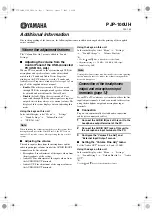
2-20
have been published since December 2000. Between them, the studies investigated
any possible association between the use of wireless phones and primary brain
cancer, glioma, meningioma, or acoustic neuroma, tumors of the brain or salivary
gland, leukemia, or other cancers. None of the studies demonstrated the existence of
any harmful health effects from wireless phone RF exposures. However, none of the
studies can answer questions about long-term exposures, since the average period of
phone use in these studies was around three years.
5. What research is needed to decide whether RF exposure from wireless
phones poses a health risk?
A combination of laboratory studies and epidemiological studies of people actually
using wireless phones would provide some of the data that are needed. Lifetime
animal exposure studies could be completed in a few years. However, 166 very large
numbers of animals would be needed to provide reliable proof of a cancer promoting
effect if one exists. Epidemiological studies can provide data that is directly applicable
to human populations, but ten or more years followup may be needed to provide
answers about some health effects, such as cancer. This is because the interval
between the time of exposure to a cancercausing agent and the time tumors develop
— if they do — may be many, many years. The interpretation of epidemiological
studies is hampered by difficulties in measuring actual RF exposure during day-to-
day use of wireless phones. Many factors affect this measurement, such as the angle
at which the phone is held, or which model of phone is used.
6. What is the FDA doing to find out more about the possible health effects of
wireless phone RF?
The FDA is working with the U.S. National Toxicology Program and with groups
of investigators around the world to ensure that high priority animal studies are








































